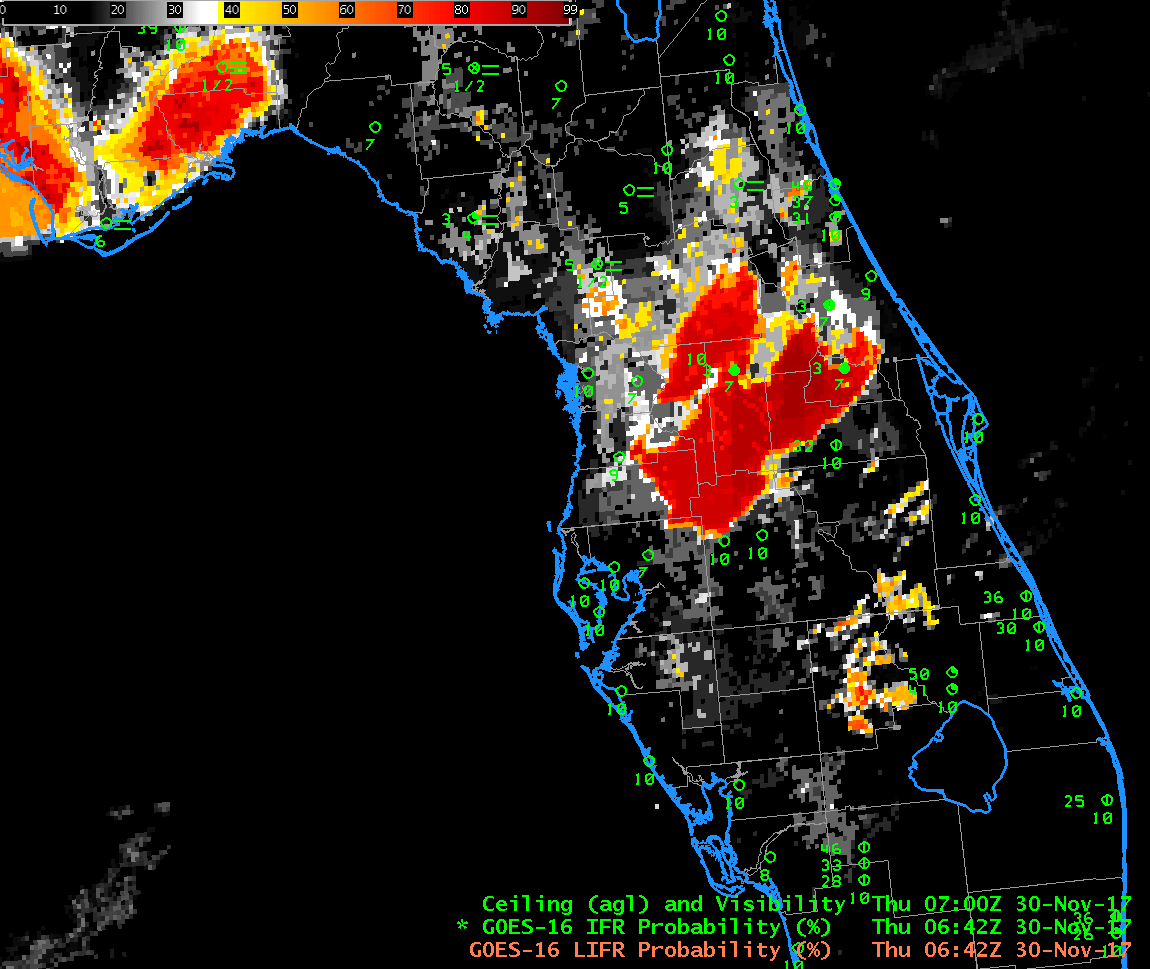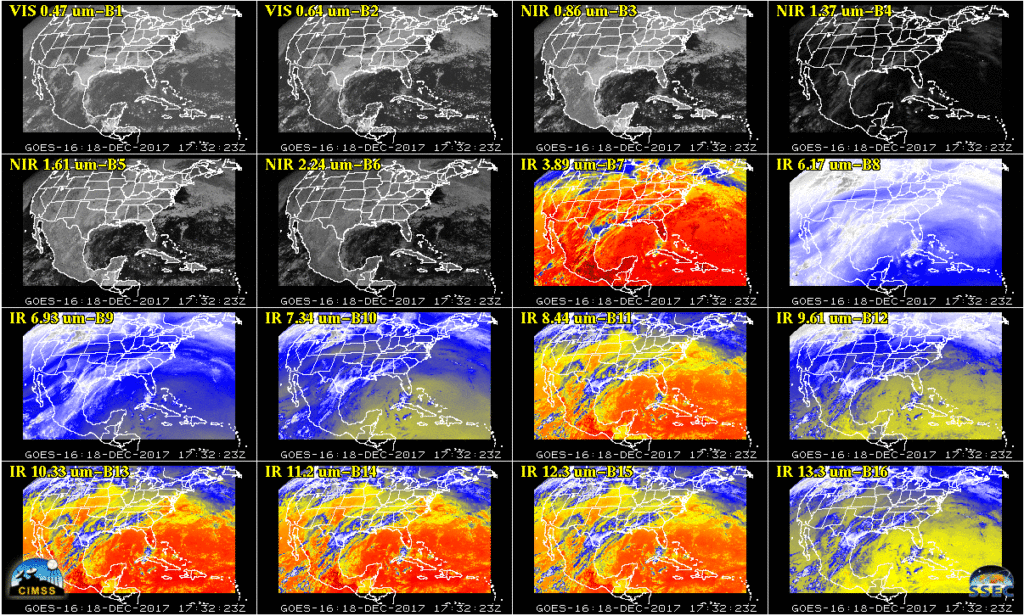
[ Archive ]

 |
CIMSS-NOAA Weekly Report [ Archive ] |
 |
ASPB AND CIMSS WEEKLY HIGHLIGHTS FOR THE WEEK ENDING DECEMBER 22, 2017
IN THE PRESS:
SSEC and CIMSS Scientists in the News: End of Year Highlights 2017: A milestone year for satellite scientists, late 2017 saw the launch of the polar-orbiting satellite JPSS-1 while earlier in the year, routine data began streaming from its newest geostationary counterpart, GOES-16. In between these events, scientists, engineers, and students at the University of Wisconsin Madison Space Science and Engineering Center and the Cooperative Institute for Meteorological Satellite Studies continued to provide the people of Wisconsin, and around the world, with cutting-edge research on the Earth and its atmosphere. Read the highlights at http://www.ssec.wisc.edu/news/articles/10458. (J. Phillips, SSEC, 608-262-8164)
ITEMS FOR THE ADMINISTRATOR:
ITEMS FOR THE ASSISTANT ADMINISTRATOR:
ITEMS FOR THE OFFICE DIRECTOR, STAR:
New GOES-16 Products for Operational Decision Support: With GOES-16 being declared operational in the eastern position, users in the National Weather Service (NWS) and elsewhere now heavily rely on information derived from GOES-16 for operational decision-making. In response to this need, STAR and the Cooperative Institute for Meteorological Satellite Studies (CIMSS) have deployed three new GOES-16 based near real-time tools. The GOES-16 fog/low stratus (FLS) products, which are used to help manage air traffic and alert the public to transportation hazards, are now available to NWS Weather Forecast Offices (WFO’s) and National Centers in Advanced Weather Interactive Processing System (AWIPS). In addition, the Probability of Severe (ProbSevere) model, distributed to NWS WFO’s in AWIPS, now utilizes GOES-16. ProbSevere is designed to increase the lead-time of severe weather warnings and GOES-16 improves the median ProbSevere lead-time compared to the previous generation of GOES. Finally, automated volcanic eruption alerts, generated using GOES-16 and the VOLcanic Cloud Analysis Toolkit (VOLCAT), are now being distributed to the Washington Volcanic Ash Advisory Center (VAAC), which is operated by NESDIS. The GOES-16 based VOLCAT alerts have already resulted in more timely operational volcanic ash advisories. (M. Pavolonis, E/RA2, 608-263-9597, Mike.Pavolonis@noaa.gov, J. Brunner, CIMSS, C. Calvert, CIMSS, J. Cintineo, CIMSS, J. Sieglaff, CIMSS)
 (Click image to enlarge)
(Click image to enlarge)
Figure caption: One of the GOES-16 Fog/Low Stratus (FLS) products shows foggy conditions rapidly spreading across Florida during the overnight hours on November 30, 2017. The orange and red colors indicate a higher probability of fog. The FLS products help forecasters improve short-term fog forecasts and fog advisories.
GOES-16 Declared the Operational GOES-East Satellite: The Cooperative Institute for Meteorological Satellite Studies (CIMSS) Satellite Blog was updated with a post highlighting Geostationary Operational Environmental Satellite (GOES)-16 being declared the operational GOES-East satellite on December 18, 2017 (http://cimss.ssec.wisc.edu/goes/blog/archives/26378). (S. Lindstrom, CIMSS, 608-263-4429, T. Schmit, E/RA2, 608-263-0291, tim.j.schmit@noaa.gov)
 (Click image to enlarge)
(Click image to enlarge)
Figure caption: 16-panel image showing all bands of the GOES-16 Advanced Baseline Imager (ABI) on December 18, 2017.
Tony Wimmers VSP trip to Honolulu WFO and Regional Office: On the week of December 11-15, Tony Wimmers visited the Honolulu WFO and the Regional Office through the Visiting Scientist Program. This was timed to coincide with a trip by Jordan Gerth as well, who worked as a liaison for the visit (in addition to his other responsibilities on the trip). Tony presented updates on the “High-Pass Gravity Wave” product on the AHI/ABI (GOES-R3 Turbulence), and the MIMIC-TPW2 product (JPSS Risk Reduction). He also shadowed at the aviation forecast desk for two shifts. These activities led to a very productive exchange of the derived product features, some special needs shaped by the forecasting cycle, and other information that forecasters use in context with turbulence events. (T. Wimmers, CIMSS, J. Gerth, CIMSS)
ITEMS FOR THE DIVISION CHIEF, CoRP:
Terra Orbit and Data Continuity Panel: A. Heidinger serves on the NASA Terra Orbit and Data Continuity Panel and participated remotely in its recent meeting. Terra was launched in 1999 and is running out of fuel. The panel discussed the options developed by NASA to extend the mission and consequences on its various remote sensing applications. One option is to continue to collect data at its current observation time (10:30 am). Other options involve letting Terra drift to earlier times which would extend its life. The panel overwhelming endorsed NASA's plan to continue the mission for as long as possible in the current orbit. (A. Heidinger, E/RA2, 608-263-6757, andrew.heidinger@noaa.gov)
The next weekly report will be after New Year's.
VISITORS:
NEXT WEEK:
LOOKING AHEAD:
| Archived Weeklies Page | Submit a report item |